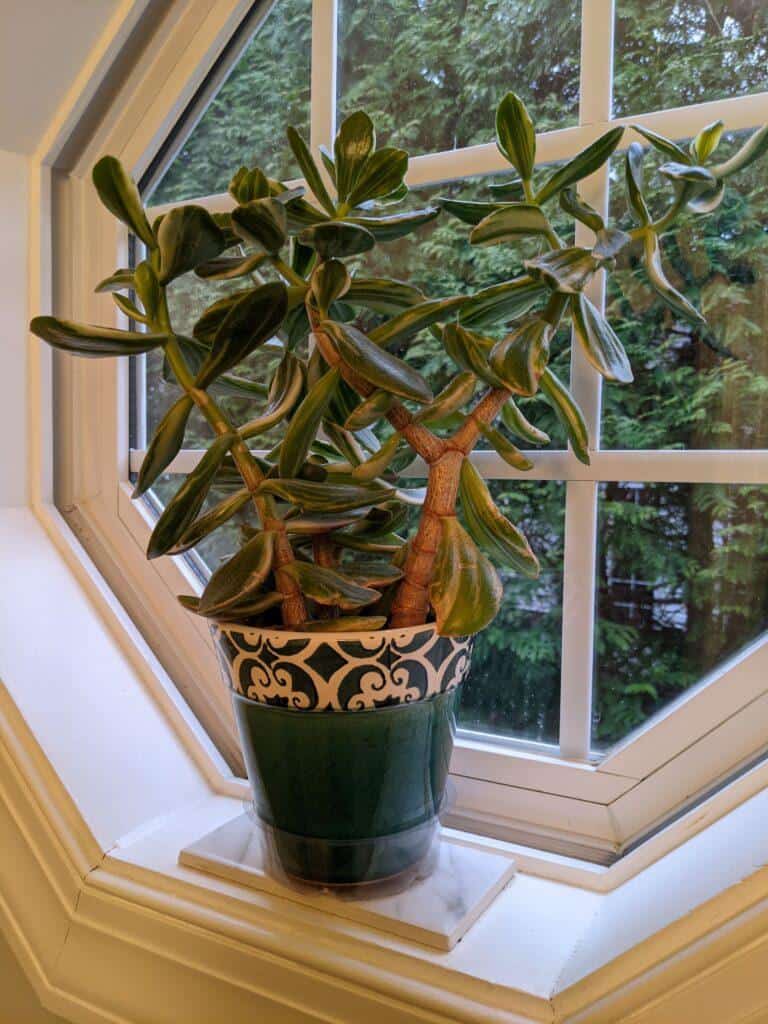Jade Plants are very popular houseplants. Variegated Jade Plants are harder to come by, so you see them less often. They sport stunning leaves with white stripes through the green leaves. The leaf tips can turn red as well provided they receive enough sun light. This succulent is a favorite among plant enthusiasts for its unique look and ease of maintenance. Although they are easy, there’s nuance to every plant’s care. To help your Variegated Jade thrive, it’s essential to understand its specific care requirements, including proper watering, light needs, soil type, and fertilization.

Variegated Jade Plant Quick Care Guide
If you’re just here for the quick rundown, then check out the table below to understand the basic needs for a Variegated Jade. If you’re looking for more in depth tips, then read on.
| Light Needs | Watering Needs | Soil Needs | Fertilizing Needs |
| Bright direct light. | The top inch should be dry before watering. | Well draining potting soil. | Every 4- 6 weeks during the growing season. |
Watering Your Variegated Jade Plant
Variegated Jade Plants prefer to dry out between waterings. The time to dry can range from a few days to over a week, depending on light, your home’s humidity, and the season. To assess soil moisture, you can stick your finger about an inch into the soil to see if it feels dry. Alternatively, you can use a soil moisture meter to tell whether your soil is dry. I’ve used one for years and find it very handy because you can measure the moisture deeper in the pot. Jade Plants also offer another, less precise way to tell when they need water. If you lightly squeeze the leaves if they have some give or have even become a little wrinkly, then it needs to be watered.
Overwatering a Variegated Jade
One of the most common mistakes with Variegated Jade Plants, and succulents in general, is overwatering. Succulents are adapted to arid conditions and hold a lot moisture in their leaves. When you over provide water, the roots and leaves will get to a point where they can no longer absorb water, this will leave the soil wet which is a breeding ground for disease. The most common problem from overwatering is root rot.
Other Watering Tips
When you water it’s best to water deeply and then let the plant dry out as opposed to frequent small sips of water. Be sure to use a pot with drainage holes. Water needs to be able to drain freely from the bottom of the pot or you risk overwatering. When you water pour water directly into the soil not on the leaves or stems of the plant water droplets on the leaves can cause stains.
Variegated Jade Plant Light Needs
To have you Variegated Jade Plant looking its best, you should provide it bright direct light. This means keeping it near a window if it’s indoors. You get the brightest light from south- and west-facing windows. To maintain even growth, you should rotate your Jade a quarter of a turn every two weeks. A Variegated Jade that is receiving adequate light will show signs of “sun stress” which is just a term plant people use for red edges that develop on Jade Plants that get ample light.
Low-Light Tolerance
Variegated Jades prefer bright light, but can tolerate lower light conditions. It’s not going to look good though. When Variegated Jades are kept in lower light their growth may slow, new leaves will develop with little or no variegation, and the growth between leaves will become stretched out (etiolation).
Soil Mix
Variegated Jades don’t need a special Jade potting mix. Most potting mixes will do minor or no adjustments. If you have any regular potting soil, that can work but it’s best if you amend it with some perlite or some other substrate to help drainage since regular potting soil is often formulated to hold moisture. A potting soil for cacti or succulents can be used without amendments. Don’t pack down the soil either as it’s important for the roots to have good aeration.
Repotting
You should repot your Variegated Jade Plant every two to three years to refresh the soil and provide more room for growth. Jades don’t have very large root systems so they don’t need larger pots very often. When you do repot choose a pot that is an inch or two larger than the root ball. An overly large pot may result in overwatering because it will be harder for the soil to dry out.
Fertilizing Your Variegated Jade Plant
Proper fertilization is key to promoting healthy growth in your Variegated Jade Plant. They are not heavy feeders. During the growing season (spring and summer), you should fertilize your Jade Plant every four to six weeks. Do not fertilize in the winter when the plant is dormant, it’s not good to promote growth when there is a lack of light.
Type of Fertilizer
Use a balanced, water-soluble fertilizer. Balanced means it has equal, or nearly equal parts of the three main plant nutrients nitrogen, phosphorus, and potassium (n-p-k). Some common ratios you see in houseplant fertilizers are 20-20-20 or 14-14-14, both of which will work fine for a Jade. Always follow the packaging instructions for dilution, a common thing people overlook.
The Variegated Jade Plant is a beautiful and resilient addition to your indoor garden. If you have any other Variegated Jade questions, post them in the Comments.

I'm a long time plant lover on the quest to happily coexist with as many plants as I can. Let's grow!
